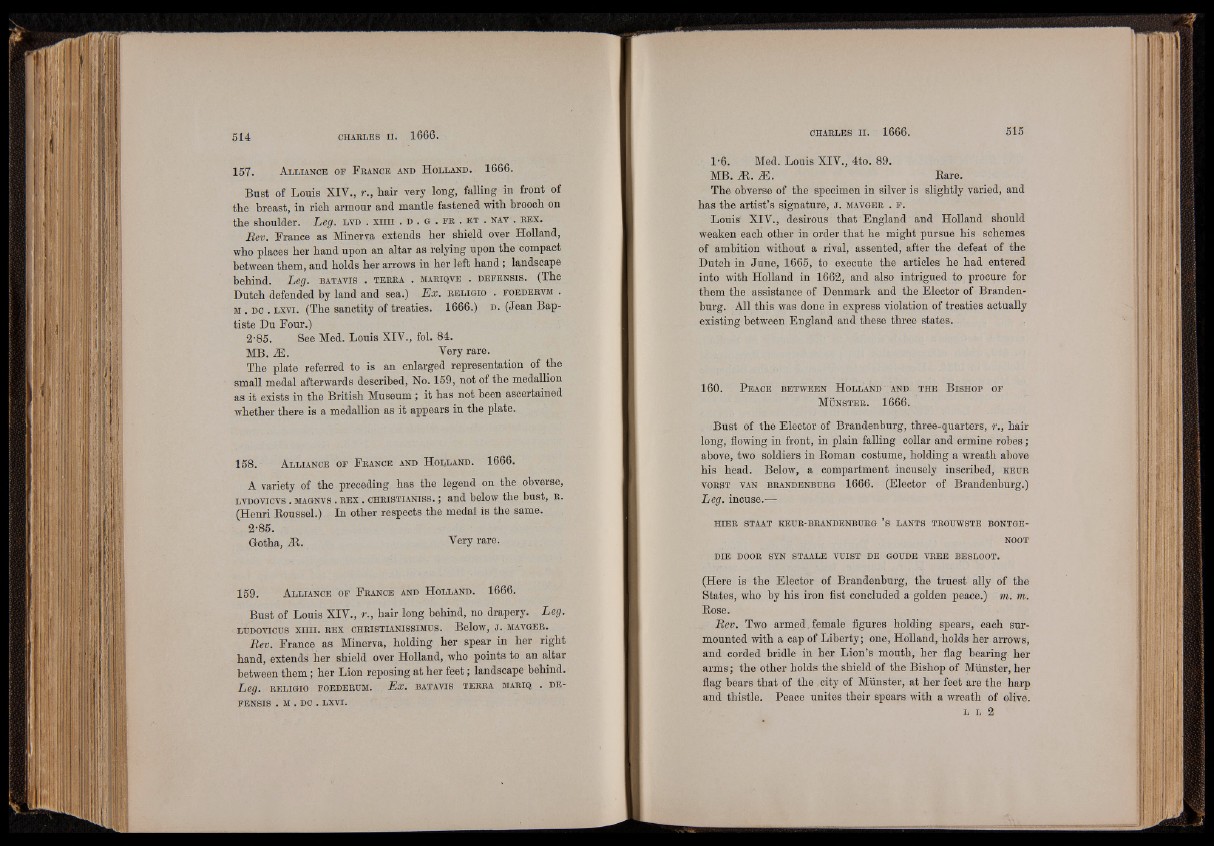
157. A l l ia n c e o f F r a nc e and H o l la n d . 1666.
Bust of Louis XIV., r., hair very long, falling in front of
the hreast, in rich armour and mantle fastened with brooch on
the shoulder. Leg. l t d . x i i i i . d . g . f r . e t . nay . r e x .
Rev. France as Minerva extends her shield over Holland,
who places her hand upon an altar as relying upon the compact
between them, and holds her arrows in her left hand ; landscape
behind. Leg. batavis . t e r r a . m ar iqye . d e f e n s is . (The
Dutch defended by land and sea.) Ex. r e l ig io . fo e d e r vm .
m . dc . l x v i . (The sanctity of treaties. 1666.) d . (Jean Baptiste
Du Four.)
2-85. See Med. Louis XIV., fol. 84.
MB. M. Very rare.
The plate referred to is an enlarged representation of the
small medal afterwards described, No. 159, not of the medallion
as it exists in the British Museum ; it has not been ascertained
whether there is a medallion as it appears in the plate.
158. A l l ia n c e o f F ra nc e and H o l la n d . 1666.
A variety of the preceding has the legend on the obverse,
lvdovicvs . magnvs . r e x . c h r is t ia n is s . ; and below the bust, r .
(Henri Roussel.) In other respects the medal is the same.
2-85.
Gotha, 2R. Very rare.
159. A l l ia n c e o f F r a nc e and H o l la n d . 1666.
Bust of Louis XIV., r., hair long behind, no drapery. Leg.
LUDOVICUS XIIII. REX CHRISTIANISSIMUS. Below, J . MAVGER.
Rev. France as Minerva, holding her spear in her right
hand, extends her shield over Holland, who points to an altar
between them; her Lion reposing at her feet; landscape behind.
Leg. RELIGIO FOEDERUM. Ex. BATAVIS TERRA MARIQ . DEFENSIS
. M . DC . LXVI.
. 1-6. Med. Louis XIV., 4to. 89.
MB. iR. iE. Rare.
The obverse of the specimen in silver is slightly varied, and
has the artist’s signature, j . mavger . f .
Louis XIV., desirous that England and Holland should
weaken each other in order that he might pursue his schemes
of ambition without a rival, assented, after the defeat of the
Dutch in June, 1665, to execute the articles he had entered
into with Holland in 1662, and also intrigued to procure for
them the assistance of Denmark and the Elector of Brandenburg.
All this was done in express violation of treaties actually
existing between England and these three states.
160. P ea c e b e tw e e n H olland ' and t h e B is h o p of
M ü n s t e r . 1666.
Bust of the Elector of Brandenburg, three-quarters, r., hair
long, flowing in front, in plain falling collar and ermine robes;
above, two soldiers in Roman costume, holding a wreath above
his head. Below, a compartment incusely inscribed, k e u r
v o rst van Br a n d en bu r g 1666. (Elector of Brandenburg.)
Leg. incuse.—
HIER STAAT KEUR-BRANDENBURG ’s LANTS TROUWSTE BONTGENOOT
DIE DOOR SYN STAALE VUIST DE GOUDE VREE BESLOOT.
(Here is the Elector of Brandenburg, the truest ally of the
States, who by his iron fist concluded a golden peace.) m. m.
Rose.
Rev. Two armed, female figures holding spears, each surmounted
with a cap of Liberty; one, Holland, holds her arrows,
and corded bridle in her Lion’s mouth, her flag bearing her
arms; the other holds the shield of the Bishop of Miinster, her
flag bears that of the city of Miinster, at her feet are the harp
and thistle. Peace unites their spears with a wreath of olive.
l l 2